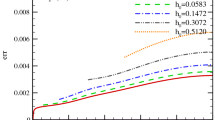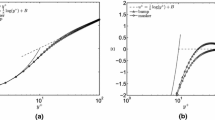Abstract
The conventional Clauser-chart method for determination of local skin friction in zero or weak pressure-gradient turbulent boundary layer flows fails entirely in strong pressure-gradient situations. This failure occurs due to the large departure of the mean velocity profile from the universal logarithmic law upon which the conventional Clauser-chart method is based. It is possible to extend this method, even for strong pressure-gradient situations involving equilibrium or near-equilibrium turbulent boundary layers by making use of the so-called non-universal logarithmic laws. These non-universal log laws depend on the local strength of the pressure gradient and may be regarded as perturbations of the universal log law. The present paper shows that the modified Clauser-chart method, so developed, yields quite satisfactory results in terms of estimation of local skin friction in strongly accelerated or retarded equilibrium and near-equilibrium turbulent boundary layers that are not very close to relaminarization or separation.








Similar content being viewed by others
References
Aubertine CD, Eaton JK (2005) Turbulence development in a non-equilibrium turbulent boundary layer with mild adverse pressure gradient. J Fluid Mech 532:345–365
Bradshaw P, Ferriss DH (1965) The response of a retarded equilibrium turbulent boundary layer to the sudden removal of pressure gradient. NPL Aero Report 1145
Brereton GJ (1989) Deduction of skin friction by Clauser technique in unsteady turbulent boundary layers. Exp Fluids 7:422–424
Buschmann MH, Gad-el-hak M (2003) Generalized logarithmic law and its consequences. AIAA J 41(1):40–48
Chauhan KA, Nagib HM, Monkewitz PA (2007) Evidence on non-universality of Kármán constant. In: Proceedings of iTi conference in Turbulence 2005, Springer, Proceedings in Physics, Progress in turbulence II, Part IV:159–163
Clauser FH (1954) Turbulent boundary layers in adverse pressure gradients. J Aeronaut Sci 21:91–108
Clauser FH (1956) The turbulent boundary layer. Adv Appl Mech 4:1–51
Coles DE (1968) The young person’s guide to the data. In: Coles DE, Hirst EA (eds) Proceedings of AFOSR-IFP-STANFORD conference on computation of turbulent boundary layers, vol II
Dixit SA, Ramesh ON (2008) Pressure-gradient-dependent logarithmic laws in sink flow turbulent boundary layers. J Fluid Mech 615:445–475
Erm LP, Joubert PN (1991) Low-Reynolds-number turbulent boundary layers. J Fluid Mech 230:1–44
Fernholz HH (2006) The role of skin-friction measurements in boundary layers with variable pressure gradients. In: Meier GEA, Sreenivasan KR (eds) IUTAM symposium on One Hundred Years of Boundary Layer Research, Springer
Fernholz HH, Warnack D (1998) The effects of a favourable pressure gradient and of the Reynolds number on an incompressible axisymmetric turbulent boundary layer Part 1. The turbulent boundary layer. J Fluid Mech 359:329–356
Fernholz HH, Janke G, Schober M, Wagner PM, Warnack D (1996) New developments and applications of skin-friction measuring techniques. Meas Sci Technol 7:1396–1409
Herring HJ, Norbury JF (1967) Some experiments on equilibrium turbulent boundary layers in favourable pressure gradients. J Fluid Mech 27:541–549
Jones MB, Marusic I, Perry AE (2001) Evolution and structure of sink flow turbulent boundary layers. J Fluid Mech 428:1–27
Kendall A, Koochesfahani M (2008) A method for estimating wall friction in turbulent wall-bounded flows. Exp Fluids 44:773–780
MacMillan FA (1956) Experiments on Pitot-tubes in shear flow. ARC London R&M 3028
McKeon BJ, Li J, Jiang W, Morrison JF, Smits AJ (2004) Further observations on the mean velocity distribution in fully developed pipe flow. J Fluid Mech 501:135–147
Millikan CB (1938) A critical discussion of turbulent flows in channels and circular tubes. In: den Hartog JP, Peters H (eds) Proceedings of 5th international congress on applied mechanics, Wiley/Chapman & Hall, pp 386–392
Musker AJ (1979) Explicit expression for the smooth wall velocity distribution in a turbulent boundary layer. AIAA J 17(6):655–657
Nagib HM, Chauhan KA (2008) Variations of von Kármán coefficient in canonical flows. Phy Fluids 20: Article no. 101518
Nickels TB (2004) Inner scaling for wall-bounded flows subject to large pressure gradients. J Fluid Mech 521:217–239
Österlund JM (1999) Experimental studies of zero pressure-gradient turbulent boundary layer flow. PhD thesis, Department of Mechanics, Royal Institute of Technology, KTH, Stockholm
Österlund JM, Johansson AV, Nagib HM, Hites MH (2000) A note on the overlap region in turbulent boundary layers. Phy Fluids 12: No.1 (Letters section)
Patel VC (1965) Calibration of the Preston tube and limitations on its use in pressure gradients. J Fluid Mech 23:185–208
Patel VC, Head MR (1968) Reversion of turbulent to laminar flow. J Fluid Mech 34:371–392
Rotta JC (1962) Turbulent boundary layers in incompressible flow. Prog Aeronaut Sci 2:1–220
Skåre PE, Krogstad PÅ (1994) A turbulent equilibrium boundary layer near separation. J Fluid Mech 272:319–348
Skote M, Henningson DS, Henkes RAWM (1998) Direct numerical simulation of self-similar turbulent boundary layers in adverse pressure gradients. Flow Turbul Combust 60:47–85
Spalart PR, Leonard A (1986) Direct numerical simulation of equilibrium turbulent boundary layers. In: Durst J et al (eds) Turbulent shear flows, vol 5. Springer, Berlin
Spalart PR, Watmuff JH (1993) Experimental and numerical study of a turbulent boundary layer with pressure gradients. J Fluid Mech 249:337–371
Townsend AA (1976) The structure of turbulent shear flow, 2nd edn. Cambridge University Press, UK
Wei T, Schmidt R, McMurtry P (2005) Comment on the Clauser chart method for determining the friction velocity. Exp Fluids 38:695–699
Author information
Authors and Affiliations
Corresponding author
Rights and permissions
About this article
Cite this article
Dixit, S.A., Ramesh, O.N. Determination of skin friction in strong pressure-gradient equilibrium and near-equilibrium turbulent boundary layers. Exp Fluids 47, 1045–1058 (2009). https://doi.org/10.1007/s00348-009-0698-2
Received:
Revised:
Accepted:
Published:
Issue Date:
DOI: https://doi.org/10.1007/s00348-009-0698-2




